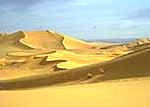 About 3.6 billion of the world's 5.2 billion hectares of useful dryland for agriculture has sufferederosionandsoil degradation. In more than 100 countries, 1 billion of the 6 billion world population is affected bydesertification, forcing people to leave their farms for jobs in the cities. About 3.6 billion of the world's 5.2 billion hectares of useful dryland for agriculture has sufferederosionandsoil degradation. In more than 100 countries, 1 billion of the 6 billion world population is affected bydesertification, forcing people to leave their farms for jobs in the cities.
Desertification takes place in dryland areas where the earth is especially fragile, where rainfall isniland the climate harsh. The result is the destruction of topsoil followed by loss of the land's ability to sustain crops, livestock or human activity. The economic impact is horrendous, with a loss of more than billion per year in agricultural goods and an increase in agricultural prices.
Climatic changes can trigger the desertification process, but human activities frequently are the proximate cause. Overcultivation exhausts the soil. Deforestation removes trees that hold the soil to the land. Overgrazing of livestock strips the land of grasses. According to a UN study, about 30% of earth's land - including the 70% of dryland - is affected by drought. Every day, about 33,000 people starve to death.
Desertification create conditions that intensify wildfires and stirring winds, adding to the tremendous pressure to earth's most precious resource, water, and, of course, the animals dependant on it. According to the World Wide Fund for Nature, the world lost about 30% of its natural wealth between 1970 and 1995.
Dust from deserts and drylands are blown into cities around the world. Dust from Africa reaches Europe through the Pasat wind, and even reaches US cities. Dust particles, which are less than 2.5 millionths of a metre in size, are inhaled, causing health problems and have been shown to boost death rates.
One of the sandiest deserts is the Takla Makan. Sandstorms can whip up the sand as high as 3,048 m (10,000 ft).
Wind-blown sand in the Sahara can be so fierce, it will sandblast the paint off a car or aeroplane.
The Sahara is almost one-third the size of Africa, and is nearly as big as the USA, the fourth largest country. It was not always a desert. Over millions of years it has been covered in ice, sea, forests and grasslands.
|
侵蚀,腐蚀
土地退化,降解
土地沙漠化
零,没有
|
